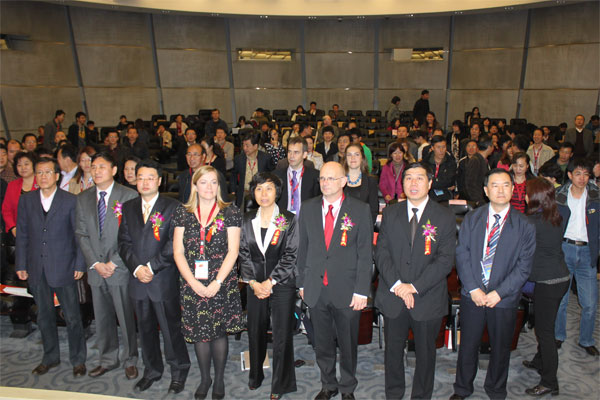Museums learn importance of being connected
- By Wu Jin
 0 Comment(s)
0 Comment(s) Print
Print E-mail
China.org.cn, October 28, 2011
E-mail
China.org.cn, October 28, 2011
Ever since the establishment of China's first museum in Nantong, Jiangsu Province 106 years ago, museums have been stereotyped as venues for education and the appreciation of objects. Now, though, Chinese museums are being confronted by shifting social trends and expectations.
Facing an overwhelming onslaught from online social networks, domestic curators can no longer cling to traditional one-way modes of communication, in which museums are considered the privileged and exclusive domains of certain types of knowledge.
"The functions of our museums fall far behind the pace of social development," said Yu Ping, deputy director of Beijing Municipal Bureau of Cultural Heritage, speaking at the Forum on Museum Development held at the Capital Museum, Beijing, on October 26, 2011.
"Museums should no longer simply be institutions for housing collections. They should expand their services to every aspect of public life, highlighting mutual communication and upgrading their services," said Yu.
|
|
|
Museum experts attend the Forum on Museum Development held in Beijing, October 26, 2011. [China.org.cn] |
The forum, which was first held in 2007, highlighted the significance of innovation and interaction, which museums must look to embrace when confronted by a fickle society transformed by rapidly developing technology. A number of overseas experts, including, Jan Sas, a Dutch lecturer in Museum Communications, Visitor Studies and Public Relations at the Amsterdam School of the Arts, Sarah Dargan, senior marketing manager from the Tate Modern, a popular art gallery in Britain and Mike Bruhn, an arts expert in charge of the arts and cultural practice in the Asia Pacific Region for Ruder Finn, one of the foremost public relations agencies, shared their experience with their Chinese counterparts during the discussion.
"Dialogue is much better than a one-way message," said Dargan. According to Sarah Dargan, personalized communications, including, emails, blogs, Facebook and Twitter are now crucial to attract audiences. She said that online social networks provide museums with platforms to advertise their latest exhibitions and receive feedback, even though some might be negative. "People are often worried about receiving negative feedback, but it can be constructive," said Dargan. She commented that, at the Tate Modern, they had also established a database of contacts, which enabled them to send targeted marketing information by email. Dargan stated that this generated significant revenue in terms of ticket sales.
This, however, is just one advantage of interactive communications. Such communications also give museums the chance to better understand their audience by categorizing visitors and then targeting specific strategies at each category of visitor. According to Jan Sas, it's important for museums to know the visitors and their preferences.
In attending the forum, Sas made his second visit to the Capital Museum. As a scholar in the field, he paid special attention to the grand building and its audience. "I think the design of the Capital Museum is wonderful. There were many children and they were having fun. But this was not a real museum visit," he commented in an email interview with China.org.cn.
Sas felt that the school children he met had not prepared adequately for their visit. He commented that their apparent aimlessness was also due to a lack of background information from both their teacher and the museum.
"The museum can give them direct access through the Internet to a teacher space where they can find all kinds of information related to their visit," Sas said. "Many visitors have a smart phone, like the iPhone. Why doesn't the museum use QR codes (which is readable by smart phones with cameras) to give visitors more background information?"
According to both Sas and Dargan, children and young people are a target audience for many European museums. "We need to develop long-term relationships with our audience, it's like a marriage," said Dargan. Tate did some marketing researches on The Tate undertook some market research among its young audience in hopes of devising relevant strategies. One of Dargan's ideas was to introduce live music performances to the gallery's traditional art exhibitions. The museum hoped the contemporary music would be a draw for young people who might otherwise see the gallery and its works as largely irrelevant.
Of course, young people are not the only targets. Any reputable museum needs a wide-ranging visitor profile if it hopes to increase its popularity. In both the Netherlands and Britain, museum scholars and staff regularly go into communities to promote upcoming or ongoing exhibitions in a bid to attract a wider range of people.
However, museums in both China and Europe now face grave challenges. In China, the challenge comes in the form of an impending reform of uncompetitive management; while in Europe, budget cuts loom as government funding shrinks due to the financial crisis. Museums must, therefore, look to make more money directly from the market, which, of course, means the visiting public. As museums are currently struggling to attract first-time visitors, they are searching for effective strategies to address the problem and turn first-timers into regular visitors. To this end, Jan Sas had some final words of advice: "Visitors must be treated specially, otherwise, why would they come back?"







Go to Forum >>0 Comment(s)